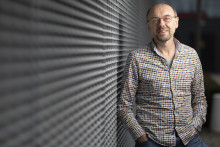An enormous square measuring ten by ten metres and one metre high was unveiled on the campus in 1975. Made of steel, it was seated on large air cushions and underneath, an ingenious pumping system reduced or increased the amount of air in the floats, causing the island to either sink or rise. Artist Ray Staakman had designed this installation at the request of the Art Committee at Technische Hogeschool Twente (Twente Technological University of Applied Sciences). Back in the early days of THT, a number of artists were commissioned to work on the Drienerlo site. The idea was (and still remains) to design art for public spaces that relates to the surroundings. For example, the artwork might be a reaction to the surrounding architecture, landscape or infrastructure, or make a reference to science.
Staakman had created an object, the shape of which was reminiscent of the flat and angular structure of Cubicus. The building actually used to be much larger than the one that stands on the site today – a fire destroyed more than half of it at one point – and it was predominantly surrounded by water. That is why water played such a key part in this design, enabling something to emerge from the pond before once more disappearing... This happened completely randomly, just as if it was some kind of Loch Ness Monster.
To the delight of all those who were present at the launch, the island sank under the surface of the water and then surfaced once more for just a brief moment, before promptly sinking.
A few years ago now, the wreck was cleared away. I personally found it rather fascinating that a gigantic slab of steel had been lying under the water for years. Hardly anyone knew about this. Plants had adapted and made it part of their biotope. Fish perhaps hid in the folds of the air cushions.
In fact, this drowned island reminds me of the Little Tower of Drienerlo in the pond in front of De Vrijhof. Wim T. Schippers also designed this in a way that intrigues and provokes. Is there an entire church standing under the water?
The latest work of art, The Head, by Atelier van Lieshout, also fires up the imagination of people. Is it a buried body with its head sticking out above the ground? You know, in the same way that you bury each other in the sand when playing on the beach? Are the feet in the basement of De Spiegel? Is that a finger sticking up between the bushes?
Other people see Squidward Tentacles, a character from SpongeBob Squarepants, in the work. Vinod Subramaniam, Chair of the Executive Board, gave a speech in which he called it a totem for our tribe.
Joep van Lieshout is of the opinion that everybody is free to interpret things in their own way, and he views this work of art very differently. He believes that the form is a nod to the mysterious heads found on Easter Island and is in fact reminiscent of modern pixels. We use our heads for thinking, something we are supposed to do at university. If you climb into the statue, you traverse through a DNA helix and from the highest viewpoint, you are able to view the world from above, hopefully conceiving new ideas. The copper exterior was chosen because copper is a material that has long been used by man, and because it will turn green over time as a result of oxidation.
But what I like best, are the unintended effects. I don't see strands of DNA inside, you see; I interpret it rather more as being the intestinal system. After all, links also exist between your gut and your mental state.
But the strongest association for me, is with Staakman's drowned island. That work measured ten by ten metres; The Head is ten metres high. Instead of a technical toy that moved away from us independently, sinking deep into the dark underworld, we now have a choice of whether we want to tackle the journey upwards on foot. For me, The Head therefore signifies freedom of choice. Do we stay planted firmly on the ground or do we look higher and aim further?
Hiska Bakker is a historian, journalist and a presenter at Studium Generale.






